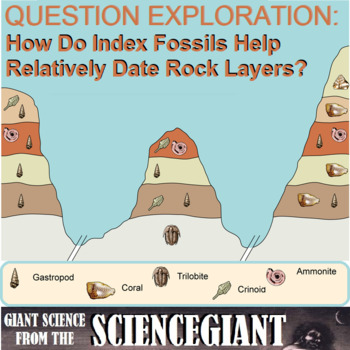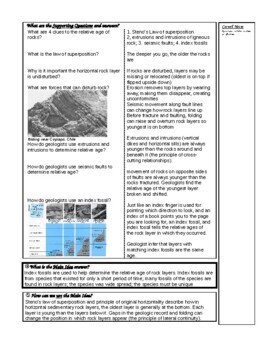Question Exploration: How do Index Fossils Help Relative Dating of Rock Layers?
- Word Document File
Description
How Do Index Fossils Help Relative Dating of Rock Layers? This Question Exploration helps Ss explain index fossils and relative dating using Steno’s law of superposition, the principle of original horizontality, and the principle of lateral continuity.
Question Exploration Routine is an instructional methods that teachers can use to help a diverse student population understand a body of content information by carefully answering a critical question to arrive at a main idea answer. The Concept Comparison Routine is used help compare and contrast key concepts. Specifically, students use like and unlike characteristics and categories shared and not shared by two or more concepts to better understand the overall concept. Students taught using the Content Enhancement routines earned higher total test scores than did students taught using the lecture-discussion method.
Personally, I use the Concept Comparison Frame Routine, and Question Exploration Routine to figure out what I want to say and how I want to say it. It keeps my "Sage on the Stage" time limited to what fits onto 2-3 pages (about 45 minutes of directed class discussion). This product includes the completed question exploration guide, and the student guide blanked except for vocabulary, scaffolding questions, and graphics already filled in.
This Question Exploration Routines are classroom tested to help students with the following Florida Next Generation Sunshine State Standards in Science.
Students Will Be Able To (SWBAT)
- SC.7.E.6.3 Identify current methods for measuring the age of Earth and its parts, including the law of superposition and radioactive dating.
- SC.7.E.6.4 Explain and give examples of how physical evidence supports scientific theories that Earth has evolved over geologic time due to natural processes
- SC.912.E.6.2 Connect surface features to surface processes that are responsible for their formation.
- SC.912.L.15.1 Explain how the scientific theory of evolution is supported by the fossil record, comparative anatomy, comparative embryology, biogeography, molecular biology, and observed evolutionary change.
- SC.912.L.15.11 Discuss specific fossil hominids and what they show about human evolution.
Related Resources
- Talk a Mile a Minute about Fossils, Plate Tectonics, Earthquakes, and Volcanoes
- Concept Compare and Question Exploration: What are the Kinds of Fossils?
- Logic LineUp: Fossils Puzzle - Petrified, Preserved Remains, Trace and Cast
- Talk a Mile a Minute about Fossils, Plate Tectonics, Earthquakes, and Volcanoes
__________
Help others #StandOnTheShouldersOfGiants -- leave a review for this resource! And it helps you #SeeFurther too -- you earn 1 credit for every $1 spent on TpT resources. Each credit has a value of 5 cents, so 20 credits earned equals $1 to apply to future TpT purchases.
#StayGiant and stay up on my new resources and STEM news. Look for the green ★ star near the top of any page within my store and click "FOLLOW". Or follow @TheScienceGiant Twitter. Stand on the Shoulders of Giants, and together we'll see further, inspire students, and enlighten inquisitive minds!





